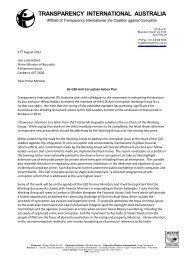'What works and why in community-based anti-corruption programs'
'What works and why in community-based anti-corruption programs'
'What works and why in community-based anti-corruption programs'
You also want an ePaper? Increase the reach of your titles
YUMPU automatically turns print PDFs into web optimized ePapers that Google loves.
What <strong>works</strong> <strong>and</strong> <strong>why</strong> <strong>in</strong> <strong>community</strong>-<strong>based</strong> <strong>anti</strong>-<strong>corruption</strong> programs<strong>and</strong> <strong>in</strong>terview public service authorities. These <strong>in</strong>teractions have taken place as a result of studentaction, either when students from government schools identified <strong>in</strong>frastructure problems <strong>in</strong> theirrespective schools <strong>and</strong> requested officials to f<strong>in</strong>d a solution, or when children attempted to solve aservice problem <strong>in</strong> their local <strong>community</strong> by contact<strong>in</strong>g the responsible agencies. Dur<strong>in</strong>g the city levelannual campaigns, groups of children from different Civic Clubs <strong>in</strong>terview the officials to probe <strong>in</strong>tocivic problems <strong>and</strong> issues. Two agencies that have shown considerable <strong>in</strong>terest <strong>and</strong> support for <strong>in</strong> theactivities of CMCA are the Traffic Police Department <strong>and</strong> the Karnataka State Pollution Control Board.Key strengths● The CMCA <strong>in</strong>itiative takes young students out of the classroom <strong>and</strong> gives them real-lifeexperiences <strong>in</strong> ‘good governance ‘ <strong>and</strong> ‘civic education’.● Participat<strong>in</strong>g schools <strong>in</strong> the CMCA program welcome the long-term approach of the program,both <strong>in</strong> runn<strong>in</strong>g through the academic year, <strong>and</strong> <strong>in</strong> return<strong>in</strong>g to schools to establish new civic clubs forthe return<strong>in</strong>g students.● By support<strong>in</strong>g local volunteer facilitators for the civic clubs, the CMCA program builds <strong>community</strong>ownership. Facilitators report a ‘sense of belong<strong>in</strong>g’ <strong>and</strong> ‘ownership’ <strong>in</strong> the program. This has resulted<strong>in</strong> high volunteer retention.● CMCA has ensured that themes <strong>and</strong> issues of its curriculum complement the civics <strong>and</strong>environmental science curricula <strong>in</strong> schools.● The program provides civic <strong>and</strong> environmental education that is locally relevant <strong>and</strong> <strong>community</strong>centred.Key challenges● A given school’s approach <strong>and</strong> commitment to the program is critical. Without support with<strong>in</strong> theschool, civic clubs cannot operate.● Susta<strong>in</strong><strong>in</strong>g student’s motivation is a cont<strong>in</strong>uous challenge for CMCA. However for students <strong>in</strong>most schools, the CMCA program aims to provide activities <strong>and</strong> education that is ‘radically different<strong>and</strong> absorb<strong>in</strong>g compared to the regular school curriculum’.A collaborative venture of Public Affairs Centre <strong>and</strong> Swabhimana, Bangalore, India________________________________________________________________________________CASESTUDY 11The follow<strong>in</strong>g program is an example of fight<strong>in</strong>g <strong>corruption</strong> through religious <strong>and</strong> ethical teach<strong>in</strong>g.Build<strong>in</strong>g <strong>anti</strong>-<strong>corruption</strong> groups <strong>in</strong> Indonesian Islamic schools, the program mobilised people <strong>in</strong> theirreligious <strong>community</strong> to monitor public spend<strong>in</strong>g <strong>and</strong> condemn <strong>corruption</strong>.Box 3.11 Anti<strong>corruption</strong> education <strong>in</strong> faith-<strong>based</strong> schools – IndonesiaThe Pesantren-Based Anti-<strong>corruption</strong> Movement is a campaign aga<strong>in</strong>st <strong>corruption</strong> <strong>based</strong> <strong>in</strong> thereligious communities of Indonesia’s Islamic board<strong>in</strong>g schools (pesantren).As <strong>in</strong>stitutes of religious education situated outside of state control, pesantren are autonomous <strong>and</strong>politically neutral. The religious leaders of pesantren, known as kiai, are also highly respected <strong>and</strong>trusted members of their <strong>community</strong>. With this underp<strong>in</strong>n<strong>in</strong>g, the Pesantren-Based Anti<strong>corruption</strong>Movement began by locat<strong>in</strong>g Islamic teach<strong>in</strong>gs that expunged the giv<strong>in</strong>g <strong>and</strong> tak<strong>in</strong>g of bribes. Work<strong>in</strong>gwith the kiai, the movement spread the message of a religious condemnation of <strong>corruption</strong> throughbooklets, pamphlets <strong>and</strong> <strong>in</strong> Friday sermons <strong>in</strong> mosques.This provided religious communities with a moral platform for their fight aga<strong>in</strong>st <strong>corruption</strong>. However,the words of moral teach<strong>in</strong>gs alone could mobilise or empower communities to <strong>in</strong>crease their struggle.Communities needed <strong>in</strong>formation on where <strong>and</strong> when public fund<strong>in</strong>g was stolen, <strong>and</strong> assistance <strong>in</strong>organis<strong>in</strong>g effective collection action. They also needed representation to take their concerns <strong>and</strong>dem<strong>and</strong>s to local government.- 28 -




